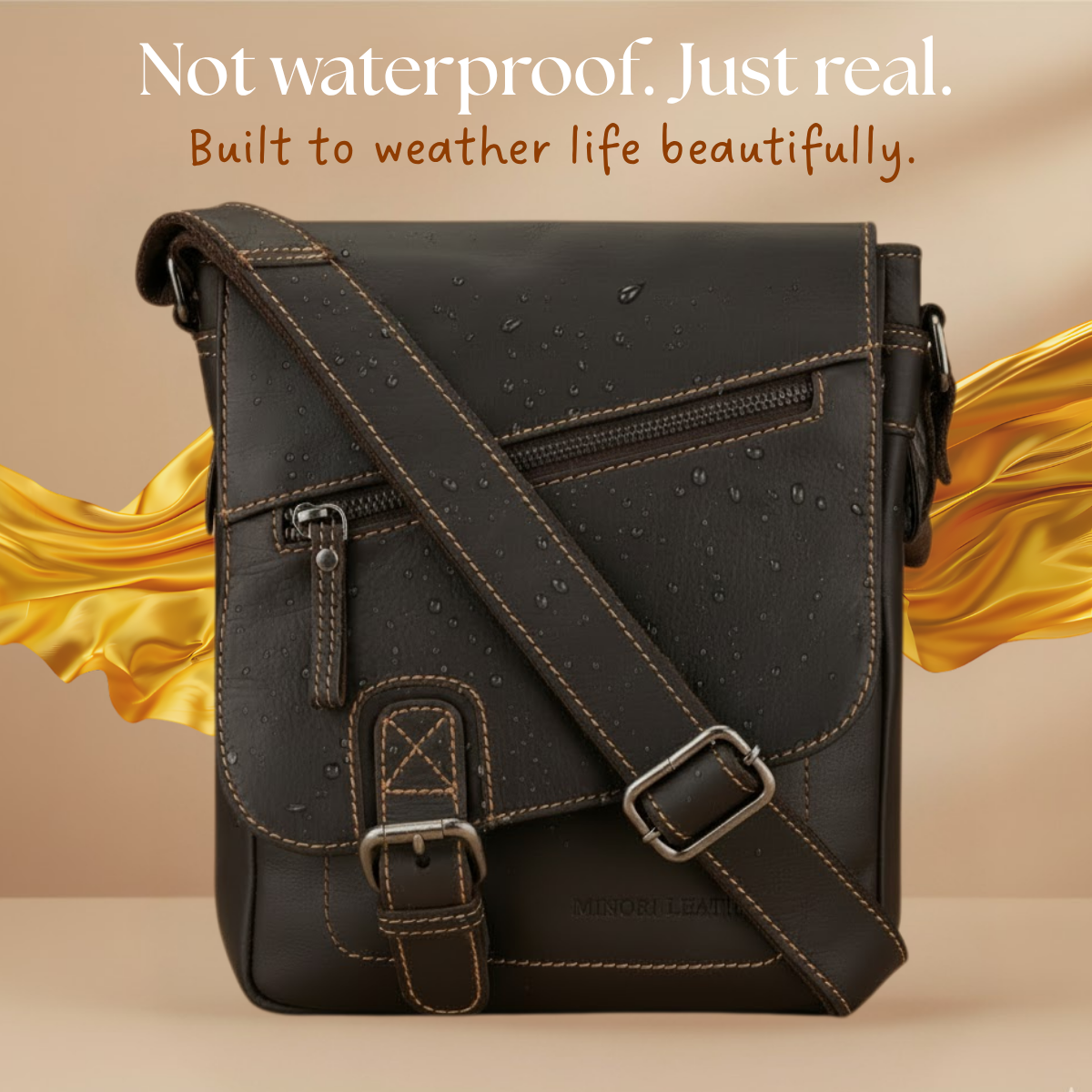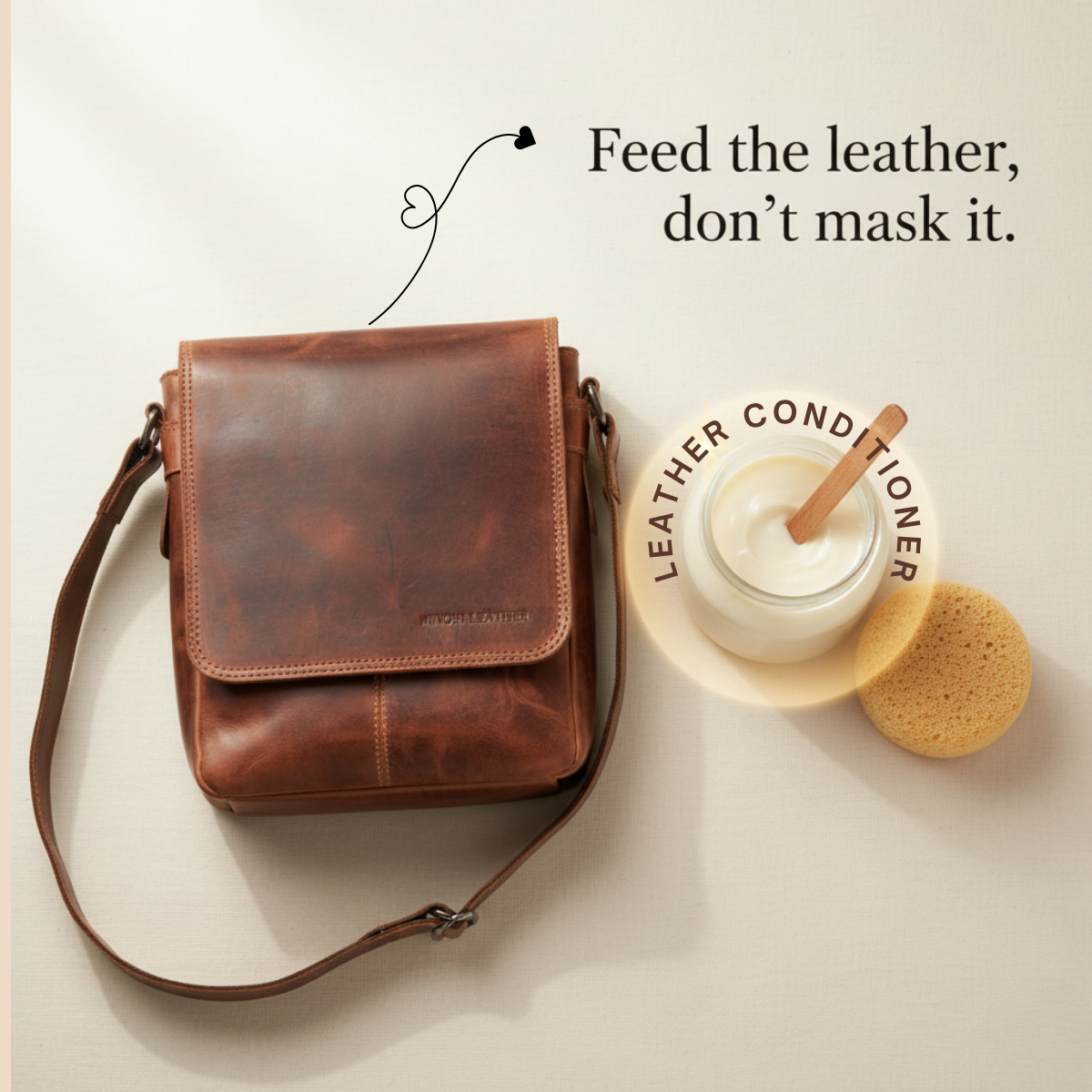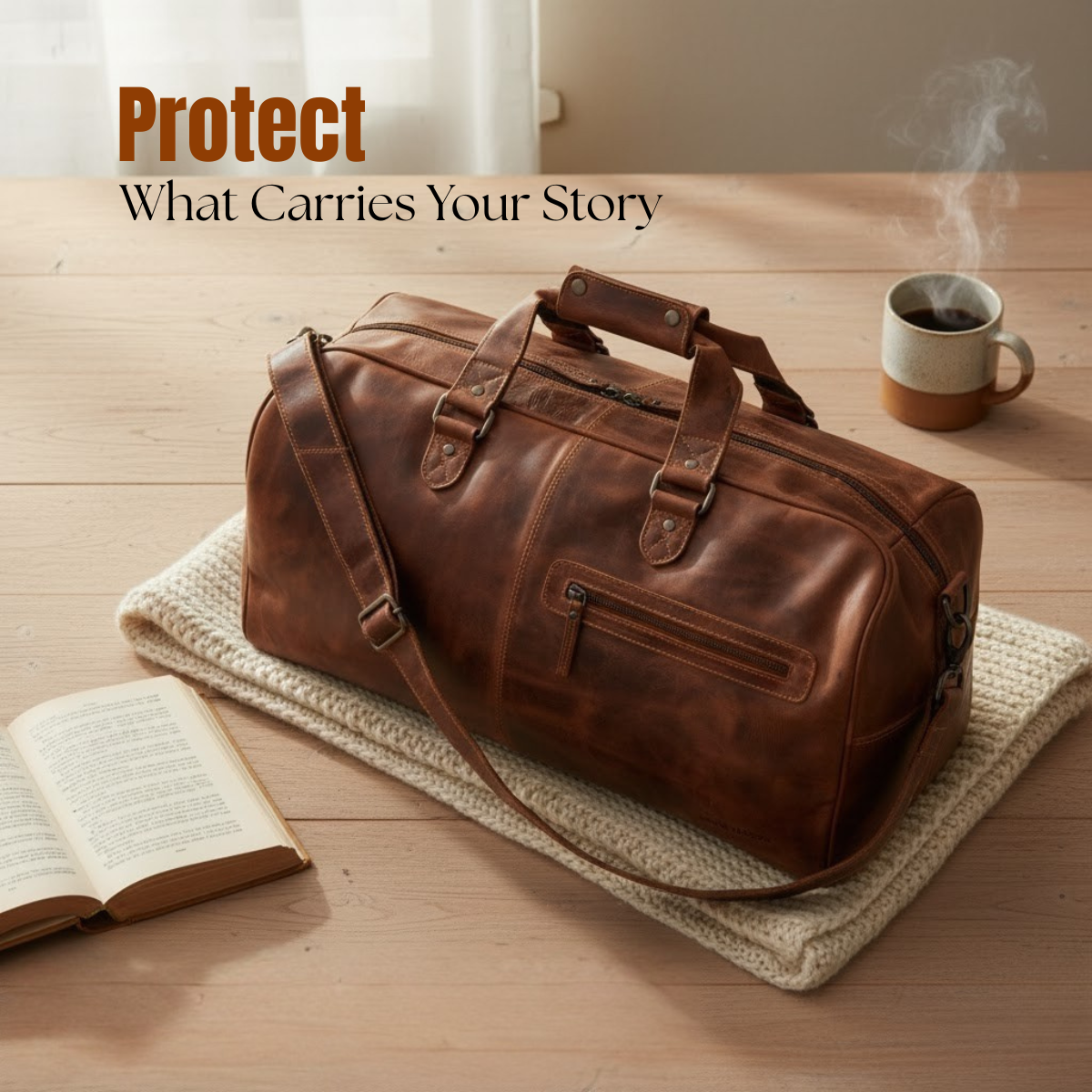
Is Leather Waterproof? The Truth About Protecting Your Leather Bags from Water Damage
The Truth About Leather and Water: How to Keep Your Bags Beautiful for Years
For anyone who has ever owned a beloved leather bag — that one piece that’s been through travels, meetings, and memories — this question always comes up sooner or later: “Is leather waterproof?”
It’s a fair question. After all, leather feels sturdy, looks timeless, and often comes with a price tag that makes you want to protect it for years. At Minori Leather, we’ve seen countless types of leather — from full-grain to faux — and each tells its own story. But one thing’s certain: no leather, no matter how premium, is completely waterproof.
So, let’s unravel the truth behind leather and water — and more importantly, how to care for it so your favorite bag stays beautiful for decades.
Is Leather Waterproof?
Leather is strong, flexible, and built to last — but it’s not naturally waterproof.
The word “waterproof” means a material forms a complete barrier against water. Leather, however, is naturally water-resistant, not waterproof. Its dense fibrous structure gives it some resistance, but it still absorbs moisture when exposed to significant water.
Different leathers handle water differently:
-
Full-grain leather (like we use at Minori Leather) can withstand light rain and occasional splashes thanks to its dense fibers.
-
Top-grain leather is slightly less resistant but still offers durability and protection.
-
Genuine leather and suede are far more porous and need regular conditioning to survive moisture exposure.
👉 In short:
-
Water-resistant = Can handle splashes or light rain.
-
Waterproof = 100% impervious to water.
Leather sits comfortably in the first category — beautiful, strong, and enduring, but it needs your care to thrive.
The Effects of Water on Leather
When leather gets wet, it absorbs moisture into its pores. As the water evaporates, it pulls out the natural oils that keep the leather supple and soft. Over time, this can cause:
-
Dryness and cracking
-
Discoloration or uneven patches
-
Stiff texture or warping
-
Mold growth if stored damp
That’s why quick, gentle care after exposure is essential. If your leather bag ever gets caught in the rain, blot it dry — don’t rub — and allow it to air-dry naturally in a cool, ventilated space.
For deeper cleaning, dry cleaning is a smart alternative. Since it doesn’t use water, it removes stains and dirt safely while preserving the texture and color of your leather.
Different Types of Leather and Their Water Resistance
Here’s how various leather types respond to water:
-
Full-Grain Leather:
The highest quality and most durable form. It has some natural resistance and develops a gorgeous patina over time. Regular waxing or a silicone-based spray can enhance its protection. -
Top-Grain Leather:
Smooth, slightly thinner, and very resistant to daily wear. Responds well to conditioning and waterproof sprays. -
Genuine Leather:
Made from the lower layers of hide — affordable but less resilient to water. Always condition and protect before using in damp environments. -
Suede & Nubuck:
Soft, velvety, and delicate. These absorb water quickly and stain easily. Use only specialized waterproof sprays — never wax — to preserve their finish. -
Faux Leather:
Made from polyurethane or PVC, faux leather doesn’t absorb water and is naturally waterproof — though it lacks the character and longevity of real leather.
How to Treat and Waterproof Leather
The goal isn’t to make leather fully waterproof — it’s to help it resist water better while retaining its natural oils. Here are proven methods:
1. Waxing
Applying a thin coat of beeswax cream or natural wax polish creates a strong outer layer that repels moisture. This method works best for full-grain and top-grain leather.
🟤 Tip: Apply a small amount with a soft cloth using circular motions, let it absorb, then buff gently for a subtle sheen.
2. Spray Protection
Silicone-based sprays form a breathable, water-repellent barrier. They’re perfect for quick applications on bags, jackets, or shoes. However, they need reapplication every few weeks if used regularly.
3. Conditioning
Leather conditioners keep your leather nourished and flexible. They restore lost oils after water exposure and help prevent cracking.
Always use conditioners specifically formulated for natural leather and apply them sparingly after drying.
Proper Drying Techniques for Wet Leather
If your leather item does get wet, follow these golden rules:
-
Avoid direct heat. Never use a hair dryer, heater, or radiator — it can warp or shrink the leather.
-
Blot, don’t rub. Use a soft, absorbent cloth to gently remove excess water.
-
Air-dry naturally. Let it rest in a cool, ventilated area away from sunlight.
-
Be patient. Leather takes time to dry properly. Rushing the process can cause permanent texture damage.
When to Seek Professional Help
If your bag or jacket suffers deep stains, mold, or cracking, it’s best to turn to a leather care professional. They can recondition the surface, restore natural oils, and apply protective finishes that aren’t available in DIY kits.
Professional restoration might seem like an extra cost, but it can add years of life to your favorite leather companion — preserving both its look and sentimental value.
Frequently Asked Questions
1. Does leather turn white when wet?
Yes, sometimes. When damp leather is stored without drying, bacteria or fungus can grow, leaving a white residue. Always ensure your leather dries completely before storage.
2. Can I waterproof leather at home?
Yes. The easiest method is applying a beeswax or natural wax cream. You can also use leather conditioners or silicone sprays — or a combination for long-term protection.
3. Is genuine leather expensive?
Yes, because creating real leather involves time-intensive tanning, skilled craftsmanship, and natural materials. It’s an investment — but one that lasts decades with care.
4. Can leather survive rain?
Light rain won’t harm high-quality leather, but prolonged exposure can. Always wipe your bag after rain and apply protective wax periodically.
5. Why does leather feel stiff after getting wet?
Because water removes the natural oils that keep leather supple. Conditioning after drying will restore its softness.
In Closing: Protect the Stories Your Leather Carries
Leather isn’t just a material — it’s a memory keeper. Every scratch, mark, and patina tells a story of journeys taken and moments lived.
While it’s not fully waterproof, with simple care and the right protection, your Minori Leather bag can weather rain, travel, and time — growing only more beautiful with age.
Because real leather isn’t meant to stay perfect.
It’s meant to age with grace — just like the stories you carry inside.



